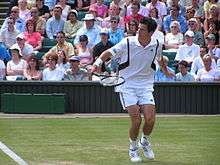Volley (tennis)
A volley in tennis is a shot in which the ball is struck before it bounces on the ground. Generally a player hits a volley while standing near the net, although it can be executed farther back, in the middle of the tennis court or even near the baseline. The word derives from M. French volée meaning flight.
The primary objective of the volley is to go on the offensive and cut the amount of time for the opponent to react. Another advantage is that a player eliminates any possibility of a bad bounce from an uneven surface such as on some grass and clay courts. Also, if near the net, a volleyer has a wider choice of angles to hit into the opponent's court. However, quick reflexes and hand–eye coordination are required to execute this shot. The primary means of countering a volley are the passing shot and the lob.
Generally, a player who advances to the net in the serve and volley type of game will make the initial volley fairly near the service line. The player will then move closer to the net in hopes of making a put-away volley for a winning point. It is difficult to hit an effective volley in the area between the baseline and the service line, consequently this is often called "no man's land".
Hitting a volley
A regular volley is hit with a short backswing and a punching stroke. While standing at the net, a player usually has no time to take a long backswing. When the ball comes at less pace, though, the volleyer can take a longer backswing to impart more force on the ball, which is called a swing volley. A player can also touch the ball lightly, so that the ball will fall just after the net. This is known as a drop volley.
Another type of volley is the drive volley. This is hit with more backswing and followthrough than a normal volley. Effectively this is a volley groundstroke and a very aggressive shot, giving your opponent less time, and can be used as a way to approach the net (approach shot).
To be effective and safe, a volley should be either (1) a drop volley that barely passes the net so the opposing player will not be able to get to it, or (2) a very sharply angled shot so that again the opponent will not be able to get to it, or (3) a hard shot that bounces very near both the opponent's baseline and the sideline and that serves as a set-up shot in anticipation of a weak return by the opponent. Any other volley will permit the opponent to get to the ball in plenty of time to make an aggressive return shot, either a lob or a passing shot.
Half volley
The lower the ball comes at the volleyer, the harder it is to hit an effective volley. In such cases, a player maybe better off to let the ball bounce and immediately hit the return on the rise rather than attempt to volley it. In this case the racquet contacts the ball almost at surface level. This is named a half volley although technically it is no longer a volley, and is one of the most difficult shots in tennis; John McEnroe, Patrick Rafter and Leander Paes were considered masters of it.
Exceptional volleyers

In his 1979 autobiography, Jack Kramer, who had a fine volley himself, devoted a page to the best tennis strokes he had ever seen. He wrote:
FOREHAND VOLLEY—Wilmer Allison of Texas, who won the 1935 Forest Hills, had the best I ever saw as a kid, and I've never seen anyone since hit one better. Budge Patty came closest, then Newcombe. BACKHAND VOLLEY—Close among Budge, Sedgman and Rosewall, with Sedgman getting the edge probably because of his quickness. Schroeder and Trabert were almost as outstanding.
Among open era (post 1968) male players, John McEnroe and Stefan Edberg and Leander Paes are generally regarded as being the finest and most natural volleyers, though some consider Patrick Rafter or Tim Henman to have been equally proficient. Pete Sampras is also regarded as having had the finest volleys in recent times.
Among open era female players, Martina Navratilova is considered to be the outstanding volleyer. Jana Novotná was also noted for her superior volleying skills.
Other male players known for their superior volleying skills include:
Female players known for their superior volleying skills include:
References
- ↑ "Ranking the 10 Best net Players in tennis Today". Bleacher Report. 3 Aug 2013. Retrieved 27 July 2015.
External links
| Wikimedia Commons has media related to Volley (tennis). |
